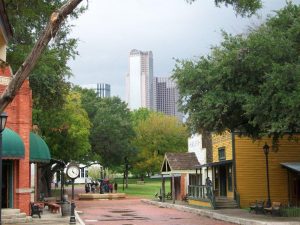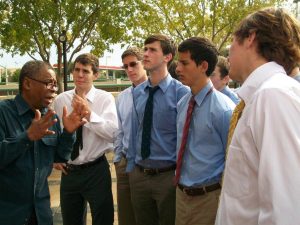On our second field trip as Senior Honors English Seminar students, we began at the Freedman’s Cemetery, established in 1861 as a resting place for African American slaves who died shortly after the Civil War. The Seminar teacher Ms. Sheryl Row introduced us to our guide for the day, her long time friend Donald Payton.
 After introductions Payton asked us, “So boys, how many people are dead in that cemetery?” Throughout our entire fieldtrip, Payton incorporated his personality into his instructive history of urban Dallas and its African American roots.
After introductions Payton asked us, “So boys, how many people are dead in that cemetery?” Throughout our entire fieldtrip, Payton incorporated his personality into his instructive history of urban Dallas and its African American roots.
Donald guided us around the memorial sculptures designed by Dallas artist David Newton and the preserved tombstones explaining their significance using anecdotes passed down from his ancestors. Kevin Butkus noted, “It was fascinating to hear they dug up bodies from what is now the highway 75 frontage road and moved them into what is currently Freedmans Cemetery. The cemetery’s rich history shows just how far Dallas has come.”
We quickly found that Donald is not only extremely knowledgeable about the subject of African American roots, but he is also extremely passionate. His wild hand gestures, laughter, jokes, and body language were unlike any other tour guide’s I have had before.
Our drive around urban south Dallas included Booker T. Washington, today an arts magnet but earlier a school for all the black students in the Dallas area. Donald also pointed out the Wylie Theater and labeled it as part of Dallas’s gentrification, investment and construction revamping downtown to turn it into a more prosperous city. 
What seemed to ring most important to Donald, however, was the Millermore Plantation. Payton is a descendant of the Miller slaves and is responsible for preserving the family cemetery which we visited. Dallas pioneer William B. Miller finished the house in 1862. The Millermore mansion was removed from its original site off Bonnie View to its present home at the Dallas Heritage Village. We also learned about and viewed shotgun houses in the area.
After lunch at Two Podners for some fantastic fried chicken and barbeque, Jack Greenwood commented, “Before, I was not much of a barbeque guy, but this place is awesome.” Our trip also included the African American Museum where we met the president Dr. Harry Robinson and the curator. The museum has one of the largest African American folk art collections in the country and also houses the artifacts removed from Freedman’s Cemetery. 
Our tour included the homes of noted civil rights leader Juanita Craft and soul music pioneer Ray Charles. Brendan O’Brien found it particularly interesting “to hear that Dallas had the largest chapter of the KKK in the U.S. and [to learn of] the impact it had on African American leadership in politics” at that time. Our tour ended with a drive through Joppa, one of the few remaining freedman’s towns in the country.
